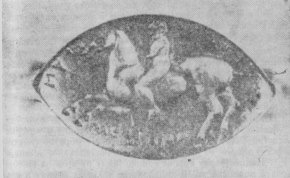3. The inscription on the golden ring from Duvanli
This ring was found next to the left hand of a skeleton in the Arabadzhjiska mould at the village of Duvanli, Plovdiv district. The ring has the image of a horseman and an inscription surrounding the image:

The golden ring from Duvanli
The inscription is only partially preserved – only 16 out of the initial 21 letters are readable:
The text of the Duvanli inscription (on the golden ring)
The interpretation of Vl. Georgiev is the following:
Text: eys, ie … dele, mezenai.
Translation: “(You) powerful, help … protect, (you) horseman!”
The image of the horseman clarifies the word mezena as meaning ‘a horseman’. The Thracian mezena (mezenai in the text) is almost identical to the name (the epithet) of the Messapian deity of (Iuppiter) Menzana, the “horse deity” to which were sacrificed horses. It also corresponds to the Albanian mes, mezi (‘a stallion’) and the Romainan mnz (‘a stallion’). The latter is Dacian in origin from the IE *mend(i)- ‘a horse’. The Thracian mezena and the Messapian Menzana – from the IE *mendiana mean ‘a horseman’.







 Reply With Quote
Reply With Quote




 ]
]
Bookmarks